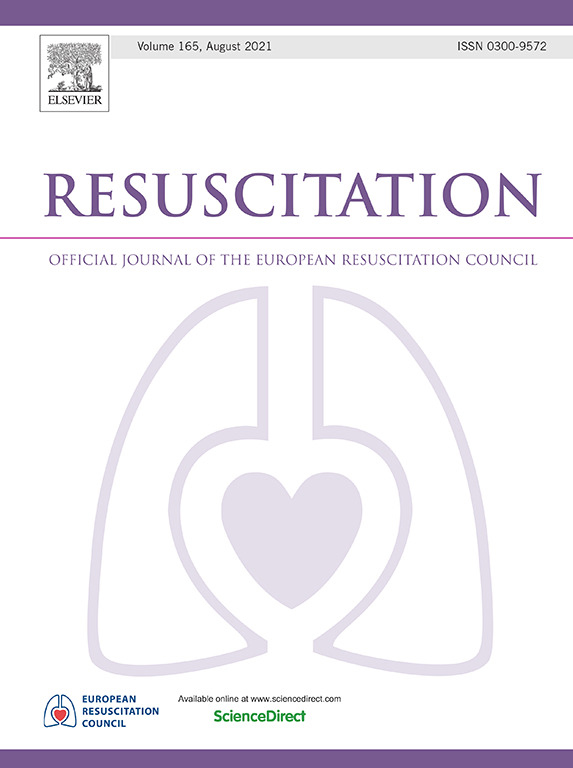How much information is needed to predict outcomes after cardiac arrest?
IF 4.6
1区 医学
Q1 CRITICAL CARE MEDICINE
引用次数: 0
Abstract
Introduction
Prognostication after cardiac arrest is challenging but may be improved with machine learning (ML). ML accommodates large quantities of data, but in practice these arise from heterogeneous sources that may be challenging to assemble. We compared ML performance with combinations of registry, electronic health record (EHR) and electroencephalography (EEG) data to test if only a subset of sources was sufficient.
Methods
We performed a cohort study including consecutive adults treated between January 2010 and February 2022 at a single hospital who were unresponsive after cardiac arrest. We developed ML models to predict poor outcome (discharge Cerebral Performance Category (CPC) of 4 or 5) from various combinations of registry, EHR and EEG data. We developed sequential models at presentation and 12-, 24-, 48- and 72-hours post-arrest, including only patients remaining hospitalized and information known at that timepoint. Our primary performance metric was sensitivity predicting poor outcome at perfect specificity (zero false positives).
Results
We included 1,106 patients of whom 773 (70 %) had poor outcome. Best performing models were random forests. At each timepoint, the best performing model included both registry and EEG data; after 12 h the best models used a combination of registry, EHR and EEG data. Peak median sensitivity at perfect specificity was 70 % (65–73 %) and occurred at 24 h. Discrimination of this model was excellent (median AUC 0.949 [0.947–0.951]).
Conclusion
Multiple data sources were needed to achieve optimal sensitivity. There is a need to develop large, comprehensive, multicenter datasets to improve post-arrest prognostication.
预测心脏骤停后的结果需要多少信息?
心脏骤停后的预测是具有挑战性的,但可以通过机器学习(ML)得到改善。ML容纳大量数据,但在实践中,这些数据来自异构源,可能很难组装。我们将机器学习的表现与注册表、电子健康记录(EHR)和脑电图(EEG)数据的组合进行了比较,以测试是否只有一部分来源是足够的。方法:我们进行了一项队列研究,包括2010年1月至2022年2月在一家医院连续治疗的心脏骤停后无反应的成年人。我们开发了ML模型,从注册表、电子病历和脑电图数据的各种组合中预测不良预后(放电脑功能类别(CPC)为4或5)。我们在发病时以及骤停后12小时、24小时、48小时和72小时建立了顺序模型,仅包括在该时间点仍住院的患者和已知的信息。我们的主要性能指标是在完全特异性(零假阳性)下预测不良结果的敏感性。结果:我们纳入了1106例患者,其中773例(70%)预后不良。表现最好的模型是随机森林。在每个时间点上,表现最好的模型同时包含了注册表和脑电数据;12小时后,最好的模型使用注册表、电子病历和脑电图数据的组合。完美特异性的峰值中位敏感性为70%(65-73%),发生在24小时。该模型的判别性极好(中位AUC 0.949[0.947-0.951])。结论:为获得最佳灵敏度,需要多种数据来源。有必要开发大型、全面、多中心的数据集,以改善骤停后的预测。
本文章由计算机程序翻译,如有差异,请以英文原文为准。
求助全文
约1分钟内获得全文
求助全文
来源期刊

Resuscitation
医学-急救医学
CiteScore
12.00
自引率
18.50%
发文量
556
审稿时长
21 days
期刊介绍:
Resuscitation is a monthly international and interdisciplinary medical journal. The papers published deal with the aetiology, pathophysiology and prevention of cardiac arrest, resuscitation training, clinical resuscitation, and experimental resuscitation research, although papers relating to animal studies will be published only if they are of exceptional interest and related directly to clinical cardiopulmonary resuscitation. Papers relating to trauma are published occasionally but the majority of these concern traumatic cardiac arrest.
 求助内容:
求助内容: 应助结果提醒方式:
应助结果提醒方式:


